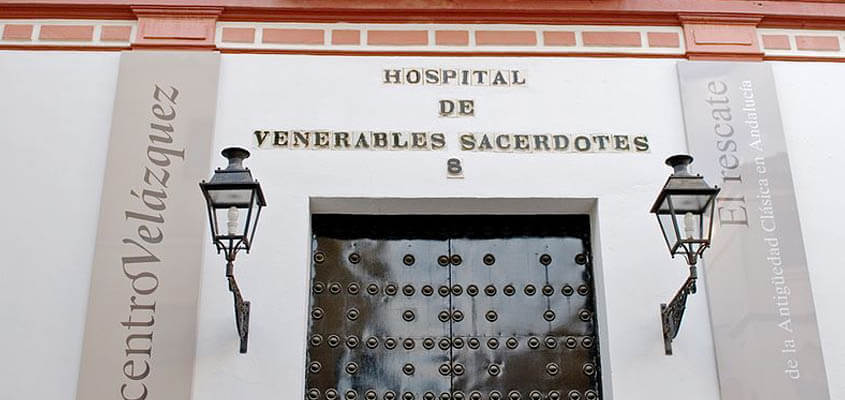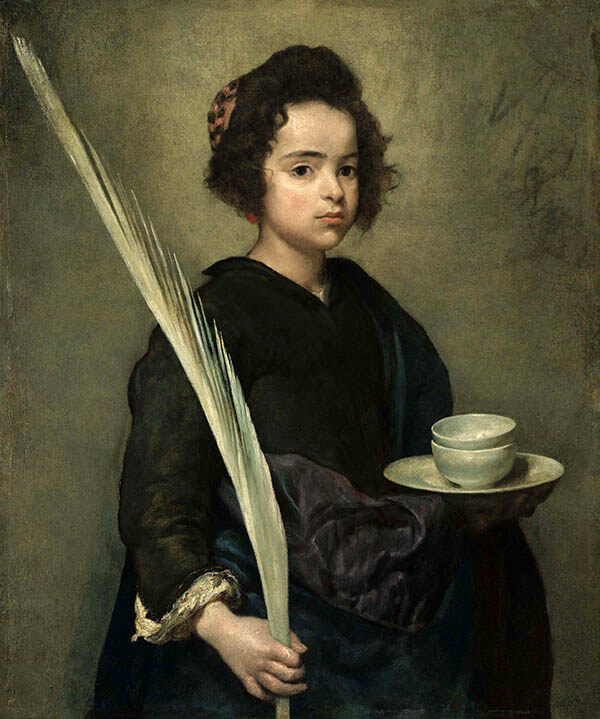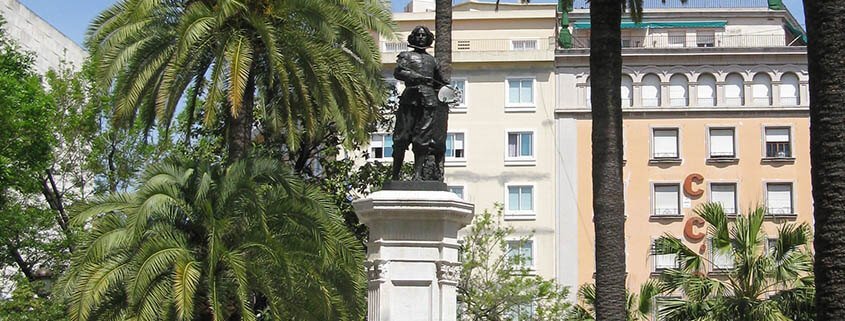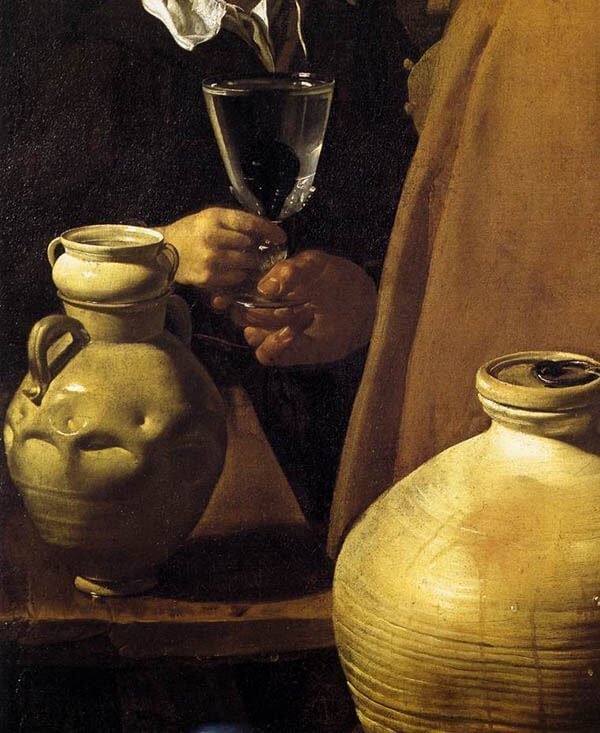Diego Velázquez, sevillian painter of painters
The nickname “painter of painters” was given by the French artist Eduard Manet, who deeply admired his work. Manet had the opportunity to contemplate his paintings in the Prado Museum, which houses the most important part of his pictorial career. However, Velázquez was born about 500 km from the court, in southern Spain, in Seville. He never forgot his origins and he signed as “pictor hispalensis”, that is, Sevillian painter.
He was born as Diego Rodriguez de Silva Velazquez, but he is known worldwide by his second surname, Velazquez, according to Andalusian tradition from Portugal.
He was the eldest son of a Sevillian family of modest fortune and, given his drawing skills, his parents sent him to train as an apprentice at the Seville painter Francisco de Herrera’s “el Viejo”workshop.
Painters workshops and academies
The bad character of this artist made the young Velázquez at the age of 11 change to another workshop also from Seville that would mark him for life, professional and personal. His new teacher was Francisco Pacheco, painter, polychromator, writer and intellectual of great reputation in Seville in the early seventeenth century.
Seville at the beginning of the century was still a great metropolis although it was beginning to be punished by the economic crisis. Culturally it was known as the New Rome and literary and artistic gatherings were frequent, one of the most popular was that of the Casa de Pilatos, residence of the Duke of Alcala, in which the Master Pacheco actively participated and perhaps Velázquez himself. There they talked about painting, poetry, history and mythology … themes that gave our young painter a great culture.
Herrera was Velazquez’s teacher until he became a professional painter after passing the exam that allowed him to open his own workshop. In addition, Velázquez would marry in 1618 with the daughter of his teacher, Juana.
To be a painter they usually started at 10 or 11 years as apprentices in a teacher’s workshop, where they trained. This system came from medieval times and was strongly linked to guilds and artisan work. Then they had to pass a master’s exam, it was then when they acquired the degree of painter and they could already start their own professional career with the right to practice throughout the kingdom.
A few years later a group of Sevillian painters: Murillo, Herrera el Joven and Valdes Leal founded a drawing and painting academy in the Casa Lonja (current Archive of the Indies) to change the guild system of learning in workshops, there they innovated using people as models. With this they intended to renew the arts and the training of painters.
But above all they intended to give a greater intellectual category to the profession of painter, until now considered as one more crafts without qualification. That was also the objective of Velazquez from another area, the Madrid court, where he worked. Always a proud painter of his art, he fought for the social and noble merit of the Cross of the Order of Saint James, to get away from the idea of the artisan painter of the Middle Ages and be part of the intellectual and noble elite of the Spanish society.
What are famous works by Velázquez in the sevillian period
Until the age of 24, Velazquez was living and working in his hometown, so we have a good number of pictures from this period, although unfortunately few of them are preserved in Seville.
Velazquez’s painting from Seville’s period is characterized by the naturalism, color and strong influence of drawing, following in the wake of Andalusian painting from the beginning of the 17th century. He mainly painted portraits, religious subjects and genre or everyday life painting.
Among the best works of the Seville period are:
- The Old woman frying eggs. 1618. Currently in the National Gallery in Edinburgh. A still life scene and portraits of humble people of his time, highly influenced by chiaroscuro, fashionable in those years.
- Adoration of the Magi. 1619. In the Prado Museum, Madrid. It is a religious theme and it has been interpreted that the models were the relatives to the painter. Francisco Pacheco, teacher and father-in-law of Velazquez would be the king Melichior, the one with the white beard. The Virgin Mary would be Velazquez’s wife, Juana Pacheco, whom he had married a year earlier, the Child Jesus would be the painter’s own eldest daughter, and Diego Velazquez would give King Caspar a face.
- The Waterseller of Seville. 1618. at the Wellington Museum, London. A great example of the imitation of nature that young painters were chasing in the 17th century. It is the portrait of “a water carrier”, a common occupation in Seville. It is also symbolically related to the three ages of man: youth, maturity and old age.
Where you can see Velázquez paintings in Seville: The hospital of venerables

In the heart of the Santa Cruz Quarter is the Hospital de los Venerables, which was a haven for elderly priests in the 17th century. Restored a few years ago, it belongs to the Focus Abengoa Foundation and houses the Velazquez Center.
This small but important collection of Sevillian baroque painting includes some of Velazquez’s paintings that are preserved in Seville, all of them from his early years.
- Portrait of Santa Rufina. It inaugurated the collection and represents one of the Holy Patronesses of Seville as a girl. If there was a “Santa Justa”, since they usually go as a couple, it has not been preserved. It includes the symbols that represent her: the palm of martyrdom and the ceramic pots that refer to her pottery trade.
- Imposition of the chasuble to San Ildefonso, property of the Seville City Council, today in the Velázquez Center.
- Immaculate Conception. A religious theme that would be very successful, especially in Seville from that time on, and a field in which our young painter also experimented.

In addition, in the Museum of Fine Arts of Seville we can see two other Velazquez: the Portrait of Canon Cristobal Suárez de Ribera and in small format a Head of Apostle.
Why there are not many paingtings of Velázquez in Seville
Either because they were sold to private individuals at the time or due to the French invasion of the early 19th century that involved a plunder of works of art in Seville, or because of the closure of convents and religious orders that owned works by Velazquez, the result is that today few of these works are in the place where they were made.
Velazquez’s Sevillian period did not last long, about five years, since in 1622 the king’s painter’s place in Madrid became vacant and through the mediation of the also Sevillian, Gaspar de Guzman, Count Duke of Olivares, Diego Velázquez left his hometown to go to the capital of the kingdom.
The gap that Velazquez left in Seville when he left in 1623 was occupied by other distinguished painters such as Zurbaran, Murillo and Valdes Leal. But that is another story…




